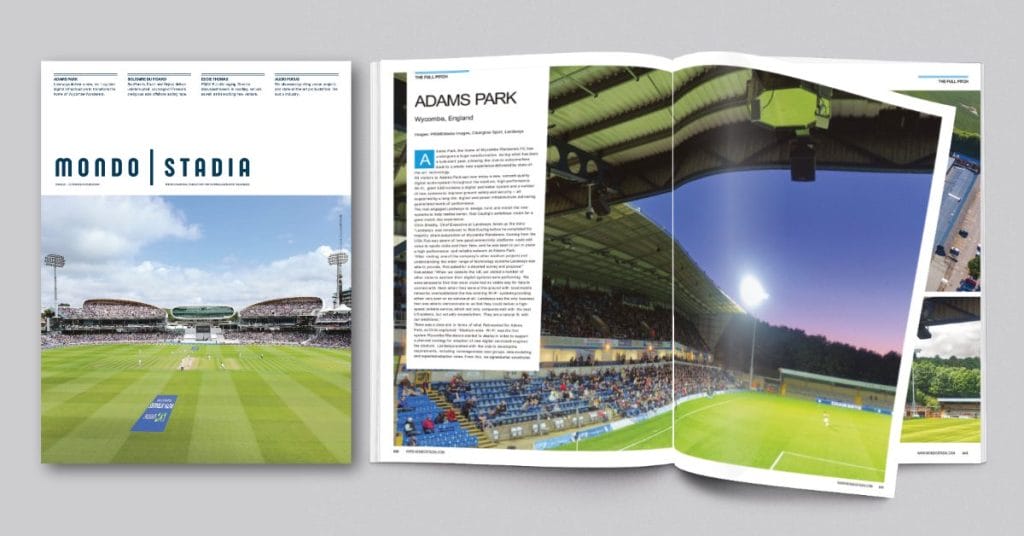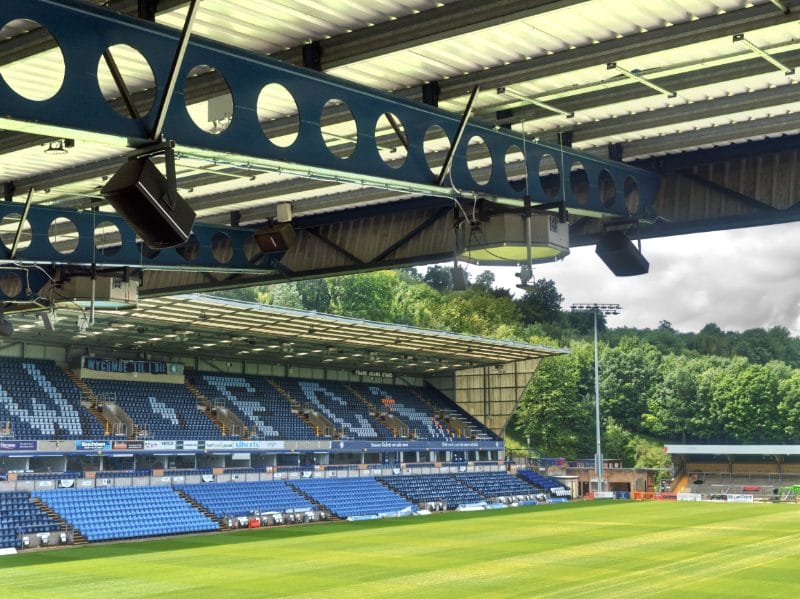Adams Park, the home of Wycombe Wanderers FC, has undergone a huge transformation during what has been a turbulent year, allowing the club to welcome fans back to a whole new experience delivered by state-of-the-art technology.

All visitors to Adams Park can now enjoy a new, concert-quality digital audio system throughout the stadium, high-performance Wi-Fi, giant LED screens, a digital perimeter system and a number of new systems to improve ground safety and security – all supported by a long-life digital and power infrastructure delivering guaranteed levels of performance. The club engaged Landways to design, fund and install the new systems to help realise owner, Rob Couhig’s ambitious vision for a great match day experience.
Chris Smedley, Chief Executive at Landways, takes up the story: “Landways was introduced to Rob Couhig before he completed his majority share acquisition of Wycombe Wanderers. Coming from the USA, Rob was aware of how good connectivity platforms could add value to sports clubs and their fans, and he was keen to put in place a high-performance and reliable network at Adams Park. “After visiting one of the company’s other stadium projects and understanding the wider range of technology systems Landways was able to provide, Rob asked for a detailed survey and proposal.” Rob added: “When we came to the UK, we visited a number of other clubs to see how their digital systems were performing. We were amazed to find that most clubs had no viable way for fans to connect with them when they were at the ground with local mobile networks overloaded and the few existing Wi-Fi systems providing either very poor or no service at all.
“Landways was the only business that was able to demonstrate to us that they could deliver a high speed, reliable service, which not only compares well with the best US systems, but actually exceeds them. They are a natural fit with our ambitions.”
ROB COUHIG, CHIEF EXECUTIVE, WYCOMBE WANDERERS
There was a clear aim in terms of what Rob wanted for Adams Park, as Chris explained: “Stadium-wide Wi-Fi was the first system Wycombe Wanderers wanted to deploy in order to support a planned strategy for adoption of new digital services throughout the stadium. Landways worked with the club to develop the requirements, including coverage areas, user groups, data modelling and expected adoption rates. From this, we agreed on what constitutes a great connectivity experience from a fan perspective and used this as the basis for creating our performance guarantee.
“The club wanted to ensure that the system would be able to cope with significant growth in data traffic, so scalability and the ability to add capacity for the contracted term with minimal disruption to the club was a key requirement.
“Another requirement was that the risk of technology selection, design and operation was passed to Landways. This led to Landways offering to invest all the capital in the initial system it had designed in return for a long-term, performance-based service contract.
“The brief quickly extended to include high-resolution surveillance cameras, a new digital audio system and improvements to several security systems, as the club exploited the initial Landways infrastructure investment to cost-effectively deploy several other high-quality new systems.”
The basis of all the new systems is the new digital and power infrastructure – it’s long-life, future-proofed and scalable, including a ground-breaking series of technical innovations. This enabled Landways to meet the guaranteed performance standards, upgrade the various systems quickly and with minimal disruption, and launch new digital services in the future at much lower cost. There are several significant features to the new digital and power infrastructure, including 200km of air-blown optical fibre, which has replaced old, capacity-limited and unreliable copper cabling. There are also distribution points installed in the stadium canopy and ceiling voids to terminate the fibre and power infrastructure and easily add or upgrade equipment in the future. A private optical fibre network to an off-site data centre has been installed, too, which allows for seamless network growth. Plus, there is a secure on-site data centre for critical network and power equipment, providing a three-hour standby time for all supported systems. Significantly, Adams Park is home to the first installation of Landways’ new containment system, Induct, which Chris explained to MONDO | STADIA in more detail:
“Induct is Landways’ new patent-pending containment system. It revolutionises the way large venues and other buildings deploy digital and power networks, both on day one and into the future. Developed in-house, it is comprised of a high-capacity, low-profile microduct system which can support optical fibre, ethernet and DC power cabling to create a flexible distribution frame.
CHRIS SMEDLEY, CHIEF EXECUTIVE, LANDWAYS
“The system can provide optical fibre and DC power to multiple connected technology systems across the site. Capable of being deployed in five-15 minutes across a typical site with no need for intermediate access, it is certified with a fire safety rating of B2ca, an important requirement in modern high-density buildings. It is significantly lighter and lower profile than conventional traywork with much higher capacity.
“Induct connects to multiple distribution points for the edge equipment, allowing core equipment to be centralised in the onsite data centre, rather than in intermediate equipment rooms. This design method makes use of underused overhead space, removes the need for excess hardware and frees up space devoted to multiple distributed communications cabinets in otherwise useful real estate. With built-in excess capacity, Landways’ Induct solution is capable of supporting seamless upgrades, additions and new technology adoption with minimal disruption.”
Adams Park also has the first DC microgrid in a European commercial venue, which saves approximately 10% of energy use and reduces the costs of power equipment by 25% when compared to a conventional power infrastructure deployment, thereby supporting the club’s plans for reduced carbon emissions.
“The DC microgrid removes the need for multiple AC/DC power conversions across the site by centrally converting AC power to DC and storing in a centralised battery storage system. All of Landways’ equipment at the edge of the network are native DC devices so this means there is no need to invert the power supply at the edge of the network,” Chris said.
“The DC microgrid and battery system also provide a three-hour battery backup for the connected systems. Entirely scalable to support additional systems, this removes the need to run multiple backup power sources across the site. Together with Inducts fire survivability and built-in resilience, this increases site safety and security in the event of an emergency.
“It is also compatible with renewable energy sources like solar panels. Solar energy is generated as DC power and can be stored in Landways’ batteries and distributed throughout the site over the DC microgrid. The potential to use the stadium roof to help reduce rising energy bills has become a point of interest for Wycombe Wanderers.”
The new digital audio system at Adams Park is an industry first, as it is designed using optical fibre and a new low power infrastructure, which distributes high-quality digital audio streams to a series of amplifiers located at the edge of the network, adjacent to more than 250 powerful new loudspeakers to serve every seat and public space in the stadium.
This unique approach combats the challenges of audibility, speech clarity, music quality and volume found in so many stadium audio systems. It enabled Landways to deliver specified levels of speech and music quality, depending on the needs of different areas of the stadium – all of which are precisely measured to give guaranteed levels of performance throughout the system’s useful life.
The installation incorporates a fully IP-based PRAESENSA public address and voice alarm system by Bosch. Control and audio distribution is courtesy of Dynacord MXE5 performance audio matrices. TPC-1 touch panel controllers provide a simple user interface, multiple inputs and easy integration with video sources. Landways has installed the touch panels in all hospitality and event spaces, allowing the club to control each area centrally or to offer private guests the ability to customise their entertainment experience on match days or at other events.
“After conducting a competitive process and having ensured that the proposal against our specification was fully compliant, we selected Bosch PRAESENSA equipment for the public address and voice alarm system and Dynacord for audio control and distribution,” said Chris.
“Our approach to Wi-Fi is also very different from conventional systems. Benefitting from the stadium-wide optical fibre and power infrastructure, we were able to avoid the capacity and performance limitations of copper ethernet cabling. All the access points for the Wi-Fi are located on or near to the distribution points and are positioned using detailed radio engineering to ensure every seat and public space can receive a signal to a minimum specified level,” said Chris.
“The underlying network has then been dimensioned using traffic models that predict and monitor data usage on the system. Because each element of the underlying infrastructure, including the backhaul connection to a nearby internet peering location, is controlled by Landways and has been designed to be upgradeable, we have been able to commit to handle both today’s traffic levels and those that are forecasted over the lifetime of the contract.”
Even in a packed bowl, fans can seamlessly stream content to their smartphones and take full advantage of mobile apps, such as the club’s new Fetch service for ordering food and drink. The Wi-Fi system already supports other digital services around the ground, including the club’s new digital ticketing system, connectivity for staff and media, and electronic payment devices in support of the club’s plan to go cashless, with more to come in the future.
“Through our partnership with Landways, we are making a long-term investment in digital technology to improve the matchday experience, reduce costs and help our business continue to thrive. The first services using the new Wi-Fi system are already up and running and we plan to introduce more in the future.
ROB COUHIG, CHIEF EXECUTIVE, WYCOMBE WANDERERS
“It is great that the same underlying energy-efficient infrastructure that delivers our incredibly fast Wi-Fi can also be used to deliver high-quality stadium audio and new safety systems, at the same time as being ready to handle data growth and new digital services in the future.”
Chris added: “We are extremely proud to work with Wycombe Wanderers and play our part in the digital transformation of Adams Park. We would particularly like to thank the Couhig family, the club’s staff and the Wycombe Wanderers Trust who have been a pleasure to work with throughout this very challenging period for us all. We are delighted that the club’s fans are now back at Adams Park and we look forward to making sure these new systems deliver to them for years to come.”
Read the full article from Mondo Stadia – Issue 20










